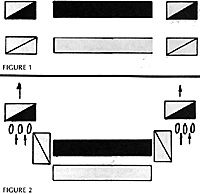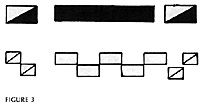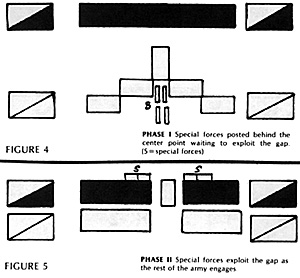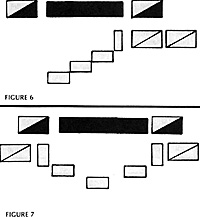 Most ancients wargamers start out with a typical formation of the phalanx of infantry in the center, flanked by the cavalry, see figure 1.
Most ancients wargamers start out with a typical formation of the phalanx of infantry in the center, flanked by the cavalry, see figure 1.
This type of formation is usually opposed by a similar formation. The results of such a head-on confrontation usually depends on the quality and quantity of a player's forces. If the opposing armies are evenly matched, the outcome of the battle depends on the roll of the dice; a situation that no player likes to be in.
After losing a number of battles this way, a player usually seeks a means to mitigate the element of chance and give him the position of advantage. One way is through the introduction of specialized forces, such as war elephants, into his deployment. The objective of the elephants would be to neutralize the enemy cavalry, thus allowing his own cavalry to attack the flanks of the enemy phalanx while his own phalanx pins it from the front, figure 2.
The introduction of specialized forces can turn the tide of battle. But the enemy will introduce his own special ized forces in retaliation, which puts both sides back on an even footing. However the first step has been taken toward the formation of a formidable force, because once both sides have neutralized each others' special forces, a need to change formation is literally thrust upon them.
 The first such change would probably be a modification of the basic formation. In order to get the advantage of the charge over his opponent a player may stagger the units in his formation so that half takes the full weight of the enemy charge, thus pinning them in place and allowing the other half to drive home with a charge against a foe without the same momentum to counter. One such formation is the CHECKERED formation, which is particularly effective against units with a wide frontage, see figure 3.
The first such change would probably be a modification of the basic formation. In order to get the advantage of the charge over his opponent a player may stagger the units in his formation so that half takes the full weight of the enemy charge, thus pinning them in place and allowing the other half to drive home with a charge against a foe without the same momentum to counter. One such formation is the CHECKERED formation, which is particularly effective against units with a wide frontage, see figure 3.
A more refined formation using the idea of a delayed impact of friendly forces is the WEDGE. The wedge formation allows a player to concentrate the greatest possible force in the most narrow frontage possible while delaying the impact of the rest of his army untill the penetrating point of the wedge can give him the advantage he is seeking.
 The point of the wedge
should pierce the line of the opposing phalanx, thus allowing fast moving specialized troops, designed to exploit such a breakthrough, to attack from the rear. The enemy forces would be helpless to turn and meet the attack from fhe rear because the wings of the wedge would now be in position to pin them from the front and thus prevent them from turning to meet the threat in the rear, figures 4 and 5.
The point of the wedge
should pierce the line of the opposing phalanx, thus allowing fast moving specialized troops, designed to exploit such a breakthrough, to attack from the rear. The enemy forces would be helpless to turn and meet the attack from fhe rear because the wings of the wedge would now be in position to pin them from the front and thus prevent them from turning to meet the threat in the rear, figures 4 and 5.
Another formation is the REFUSED FLANK. By refusing one flank, a player can concentrate his strongest forces on the leading flank which will impact first, and his weakest forces on the refused flank, which should join battle after the stronger forces have gained the advan- tage as shown in figure 6.
 The final formation is the V formation. This is a more difficult formation to use and could easily backfire against a player if things don't go as planned. Success with this formation requires strengthening both of the leading wings at the expense of the center. The advancing wings are supposed to overpower the enemy flanks and trap the remainder in the pocket formed by the V. If the leading wings are defeated the enemy forces will be in a position to launch an immediate attack against the rear while the weak center is pressed hard from the front. I
suggest that players avoid the use of this formation unless they have a decided advantage in numbers, which is necessary to insure that the wings are victorious, see figure 7.
The final formation is the V formation. This is a more difficult formation to use and could easily backfire against a player if things don't go as planned. Success with this formation requires strengthening both of the leading wings at the expense of the center. The advancing wings are supposed to overpower the enemy flanks and trap the remainder in the pocket formed by the V. If the leading wings are defeated the enemy forces will be in a position to launch an immediate attack against the rear while the weak center is pressed hard from the front. I
suggest that players avoid the use of this formation unless they have a decided advantage in numbers, which is necessary to insure that the wings are victorious, see figure 7.
The use of these formations should give a player an advantage over any player using the basic formation of the illustrations.
More Phalanx Formations in Volume IV, No. 1
Back to Table of Contents -- Courier Vol. III #4
To Courier List of Issues
To MagWeb Master Magazine List
© Copyright 1982 by The Courier Publishing Company.
This article appears in MagWeb (Magazine Web) on the Internet World Wide Web.
Other military history articles and gaming articles are available at http://www.magweb.com